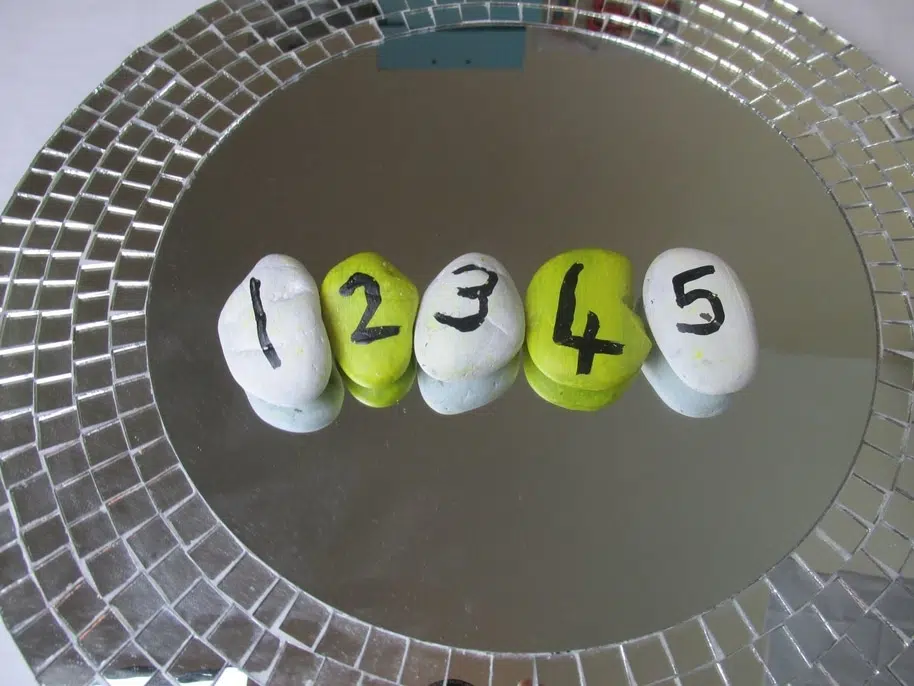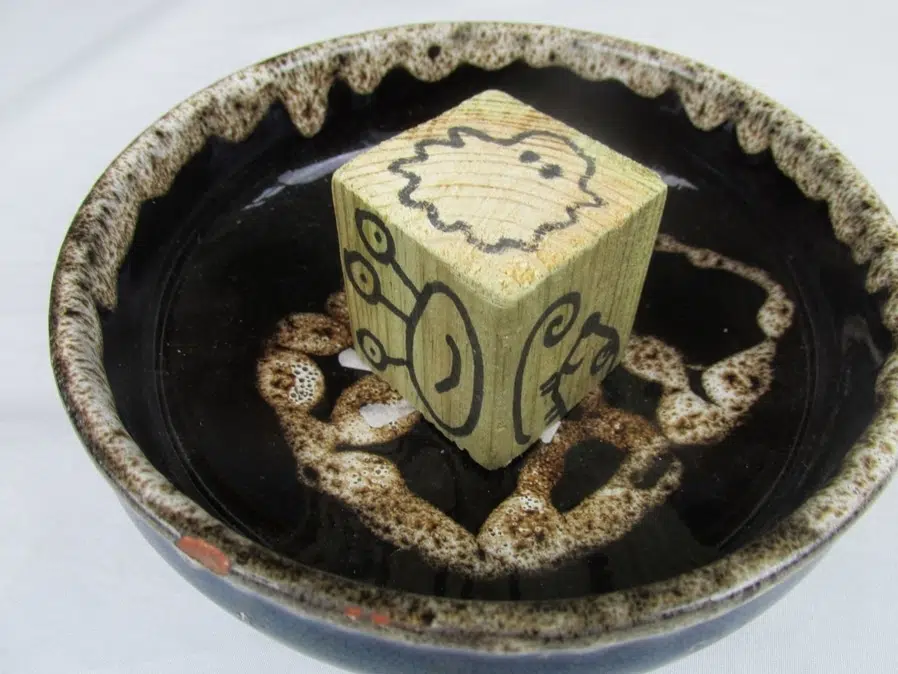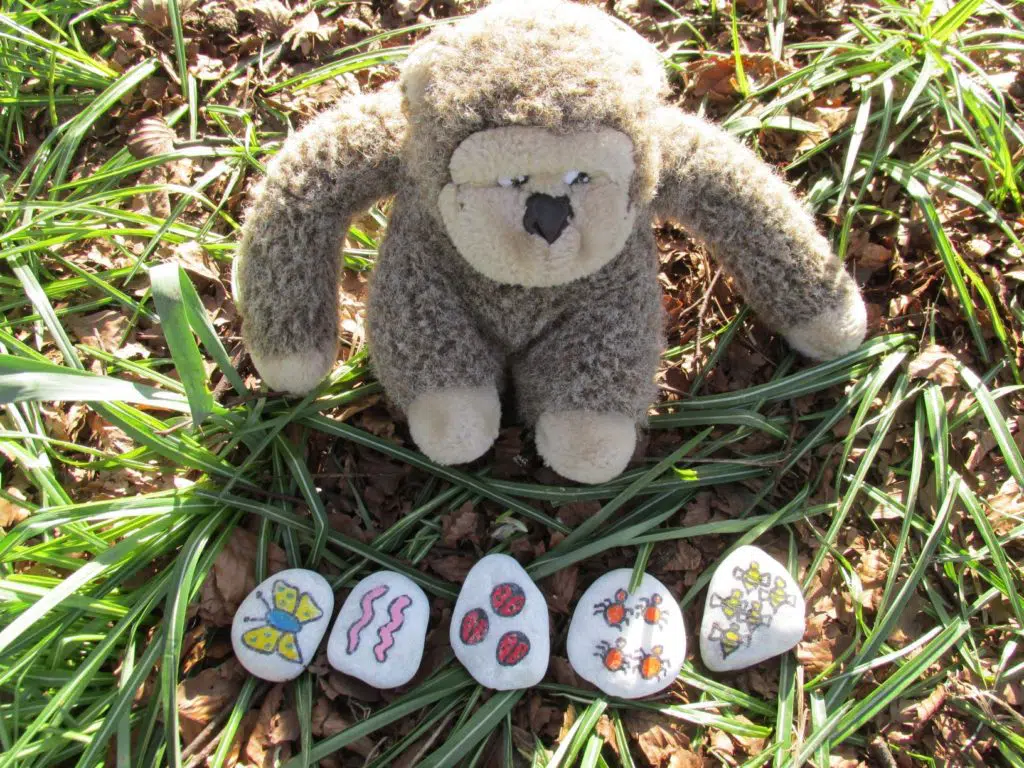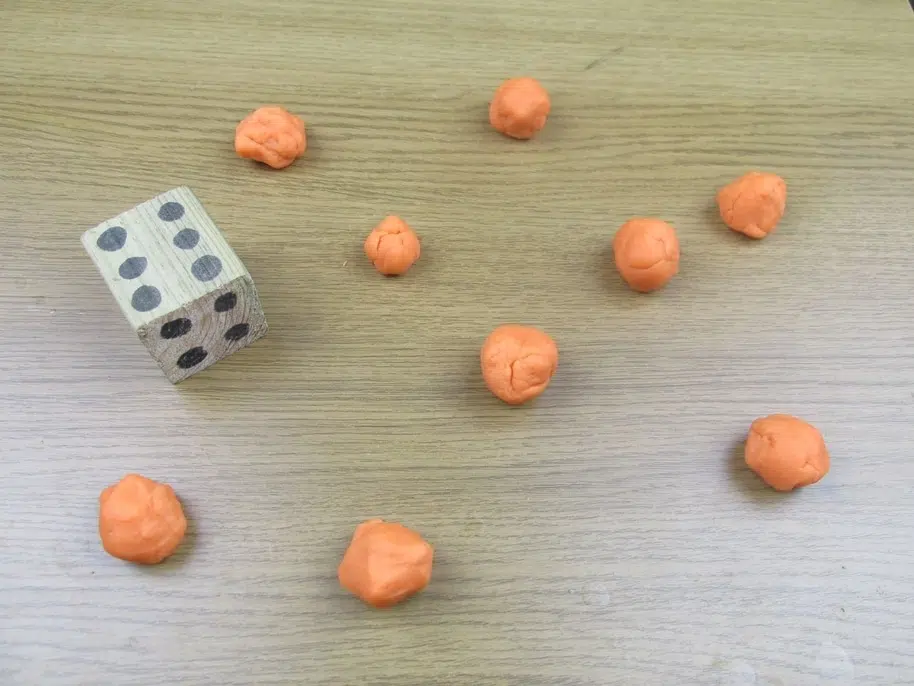One of the core skills that makes up the foundation of early math, is the ability to rote count. Rote counting is simply saying the numbers in order, usually starting with one, e.g. 1, 2, 3, 4, 5, etc. It does not mean counting objects, or counting actions, although it is connected to these skills. It just means saying the numbers in order not connected to anything.
How do you teach rote counting? Teach rote counting with simple songs that count upwards. Counting simple actions and objects that appear throughout everyday life is also recommended, for example counting stairs. Later, games such as counting while clapping or marching help the process.
Rote counting can be exciting! In fact, it is easy to make rote counting fun and usually requires very little preparation or resources to bring to life.
Find out the 17 best ways to teach children to rote count, and try these rote counting activities today! If you want to find out more about what rote counting is first, then check out this definitive guide.

1. Count Using Different Voices!
Children love taking on roles and using funny character voices. This activity taps into this enthusiasm, and uses it to bring rote counting to life!
When I do this rote counting activity, I always use the dice that I have made that have pictures of different characters. This dice started life as part of a fence post, and I simply sawed it into a cube and drew some characters onto it using a permanent marker pen.
Draw characters onto the dice that have funny or distinct voices. On the dice I use, I have drawn a princess, a mouse, a robot, an alien, a tiger, and a ghost. The ghost is my own particular favorite!

The idea is that you roll the dice and see what you get, for example, the robot. Then you simply count using a robot voice – 1, 2, 3… Try and use robot arms and really bring it to life. Count for as long as the child can manage, and definitely go just past ten if you can.
Then roll the dice and try a different voice.
If you don’t like DIY, then you could make a simple dice in another way, or alternatively just get the children to pick what kind of voice they could use. This works just fine, and rote counting is definitely not something you need lots of resources for.
This game is one of my favorite 21 preschool circle time games that you can take a look at here.
2. Counting With A Puppet
Using puppets is a fun and engaging way to practice rote counting.
Children really love puppets, and for some strange reason will often listen better to puppets than they will to real adult humans.
Tap into this strange magic by using puppets for rote counting!
If you are a parent, a puppet is a great thing to use with your child to get their attention, and the same is true if you are an educator.
There are several ways to do it. The simplest is to get the puppet to rote count, and the child to listen.
Better still is to get the puppet to count, and the child to join in.
You can extend this activity and make it harder also when the children get good at it. For example, the child/ren and puppet can say alternate numbers. If the puppet says ‘one’, the child/ren ‘two’, puppet ‘three’ etc.
The puppet can sit in a circle of children and start them off. The puppet says ‘one’, then the next child ‘two’, then the next ‘three’ etc. Puppets are great just for encouraging them to focus and getting them interested. To find out 14 more puppet math games, then check out this article.

3. Counting Songs That Count Up
Use counting songs to help build rote counting skills!
This can be one of the most successful ways of starting children off on the path of rote counting.
The problem with counting songs, however, is that most of them count backwards. This is one of the strange mysteries of counting songs. Most follow a ‘one less’ structure. You get songs such as ‘Five Little Speckled Frogs’, or ‘Five Little Men In a Flying Saucer’, that all start with five and then have one less with each verse you sing.
This is not the kind of song that children need to start rote counting. They need the songs that start with one and count upwards.
Luckily they do exist!
There are three very well-known examples of these types of songs.
One is 1, 2, 3,4,5, Once I Caught a Fish Alive. This is great for getting children to count in order to ten.
Two other examples are 1, 2, Buckle My Shoe, and 1 Potato, 2 Potato, 3 Potato, 4. For a list of ten examples of these types of songs that count up then take a look at this article.
Sing plenty of these types of songs to children, and their ability to rote count should improve. Music is a great tool for getting children really interested and tuned in to math,.
4. Counting Actions In Daily Life
This is not strictly speaking rote counting, as you are actually counting something that exists. However, it is one of the best ways of getting children rote counting, and so definitely something that I couldn’t leave out.
We all encounter sequences of numbers throughout our lives. Some classic examples that children will see a lot are things like climbing stairs.
If you count along with the child every time you climb up stairs, you are really laying a great groundwork for rote counting.
Other examples are things like jumping together and counting the jumps, or clapping and counting the claps.
5. Counting Objects In Daily Life
This is a similar idea to counting actions. This time you are just counting objects, often once again in just everyday life situations.
Great examples of this are things like counting blocks when you put them back into a box.
Counting the number of pieces of food you have, such as the number of carrots on your plate.
Or counting how many shoes you all have.
Just adding counting into the normal day-to-day is a great platform for rote counting to develop and consolidate. There are many more examples of this kind of counting in my article about one to one correspondence (and the best ways to teach it).
6. Counting In A Circle
This is a simple group game that gets everyone involved, and hopefully helps turn-taking and cooperation as well.
One child starts, and they say ‘one’. Then the next person says ‘two.’ Continue like this around the circle.
To focus their attention better, you may want to use an object. For example, get them to pass around a teddy or a puppet. Only the child who is holding the puppet can speak!
To extend this game, you can try many different things. Get them to use a different voice for example! Then they will all be counting like ghosts or aliens! This really jazzes it up.
You can also say there is one number they are not allowed to say. Or say a silly word instead of the number, like instead of saying ‘six’ say ‘sausages’ as a substitute. This develops anticipation, and also just gets them laughing and enjoying it.
7. Counting With A Partner/Adult
This game is a similar idea as the passing around the circle game. Either sit facing a partner, or an adult (whichever way you are doing it).
One person says ‘one’, the other says ‘two’, and then you just keep going like that.
When you’ve counted as far as you can go, try starting again with the other person saying one. This way you get to say the numbers you never said the first time.
These games where you take turns really get them to think, look at their partner, listen and take turns all at once.
Jazz it up by using character voices, or get them to pass something between them as they count, for example, a teddy or a ‘counting stone’ (a stone with some numbers drawn or painted on).
8. Counting In Teams
You need quite a few children to attempt this one. Get them to sit in two ‘teams’, one team facing the other.
It works well if you have something to point at the teams when it is their turn to speak. For example, a magic wand would work well for this.
Point the magic wand at the first team and they say ‘one’.
Then point at the next team, and they say ‘two’. Go back to the first, who say ‘three’.
Continue like this. It is a bit like a tennis match, with the numbers bouncing from one team to the next. Continue as far as possible, helping them out if required.
The more you do all these activities, the further they will be able to go in the long term.
9. March Counting
Moving and Math go together hand-in-hand, and this activity is great for this. Movement helps children use more parts of their brain, and enriches any learning experience.
Marching is one of the simplest ways of bringing movement to rote counting.
You quite simply get all the children to stand up, and then start marching. With the first march, they say ‘one,’ the second ‘two’ and so on. They can march around the room or outside, or they can just march on the spot.
Stamping is similar. I like to get them stamping like giants with angry faces! You can stamp and count using your giant’s voice.
This activity also lays the bedrock for understanding odd and even numbers later on.
You will be stamping on one of your feet for the even numbers, and the other foot for the even. Children will not know this is happening but will be experiencing the pattern. Experience will lead to greater understanding later on.
These games would be brilliant outdoors. To find out a whole load more outside maths games, then take a look at this article – Outdoor Maths Games – 50 Ideas That Really Work!
10. Dance Counting
It is a similar theory behind dance counting. Get them up and moving, and children are going to respond more positively and remember the skills better.
Put on some pumping music. It can be anything with a good vibrant beat.
Then pick two simple dance moves that can be done one after the other. For example, it could be throw your arms to the left, then throw your arms to the right.
Then start to count as you do the moves! Throw your arms to the left, and say ‘one’. Throw your arms to the right and say ‘two’. Keep going.
When they have gone as far as they can go, choose two more moves, and start back at one.
11. Action Counting
Movement is a key part of this idea as well. Once again, as with many of these strategies, there is no need to have any resources or prepare anything.
You simply pick an action to try and then do that action and count at the same time!
For example, the action could be jumping. Jump and count!
You could try all sorts of different movements, such as hopping, nodding, skipping, patting parts of your body, or blinking.
These things are fun, and if children have two things to focus on at once, it just seems to work better in engraining the rote counting skill.
12. Using Finger Puppets
This works well if you have enough finger puppets for all the children you are going to be doing this activity with.
Get the children to put the finger puppets on their fingers, and then use their puppet voices to count in unison. If you have lots of the same puppet then it will sound like a chorus of that voice. If you have loads of mice, for example, they will all be doing mice voices.
If you have lots of different characters for the puppets, there will instead be a great cacophony of voices merged together. Great for fun counting!
13. Whispering Like Spies
Children tend to love spies and superhero kind of role-play, and what could be better than super-spy counting?
For this one child needs a partner (or if you are a parent, then just you and your child will be partners).
You are going to whisper the numbers to each other, taking turns to say a number.
For example, one child whispers ‘one’, and the other child whispers ‘two’. Continue like that! Don’t let anyone else hear you!
Spy whispering is a super way to teach many strategies. It is mentioned in my article about tricky words, and the best 12 games to teach them.
14. Zoom Zoom Zoom Game
This is great for rote counting as well as being good for counting backwards as well as a next step.
This is a super circle game. With the children in the circle, stand in the middle of the circle and then point at one child. The idea is to slowly walk around the circle with your finger outstretched so you are slowly pointing at each child in turn. As you are doing this the children are rote counting – 1, 2, 3, etc.
When you get to 10, the child you are pointing at is the ‘astronaut’. They have to get up and stand in the middle of the circle – (the ‘rocket’). Continue again.
When you have picked about 5 children to be the astronauts, then sing the Zoom Zoom Zoom song:
Zoom Zoom Zoom
We’re going to the moon!
Zoom Zoom Zoom
We’ll be there very soon!
5, 4, 3, 2, 1, 0 – Blast Off!
Then all blast off into space with as many great sound effects as possible. Repeat the game again, trying to find new astronauts if you can.
This is one of my favorite parachute games. To check out a full selection, then take a look at these 40 greatest parachute games for kids.
15. Counting And Jumping Snake
This is a bit like a conga, brought to life even more with jumping and counting!
Stand in a big conga line. Then either all jump forward together and say ‘one’, or else all step to one side and say ‘one.’ Then jump or step to the other side and say ‘two’. Continue!
This is great outside where you can be as rowdy and raucous as you possibly want.
A fantastic activity for teamwork and helping your friends to all work together.
16. Splat The Playdoh
Playdoh math is one of the ultimate forms of getting children excited and interested in numbers.
This splat the playdoh is one of the very best.
What you need is a tuff-spot, or big tray that you can put on a table. Then get whoever is having a go of the activity to make lots and lots of little balls of playdoh.
The idea then is that a child will splat one ball of playdoh and say ‘one’. Then the next and go ‘two’, and continue like this. They can use something to do the splatting with if you like, for example, a fly swat or a small child-friendly mallet.

Keep splatting and counting!
Several children can have a go at once, or one child can have a go, and then the next, etc.
17. Clapping and counting
A nice simple one to finish, but one of the best ways to practice rote counting is by clapping at the same time as you count.
Count and clap! It’s as simple as that.
To make it trickier, you can try things like counting in a different voice and clapping at the same time. Or you can whisper like a spy, and clap.
Anything to make it engaging and bring counting to life!
Conclusion
Good luck with these rote counting activities!
Rote counting is one of the foundations of math and a crucial framework for children to build upon. However, it is definitely a fun and simple thing to teach, with not really any work or preparation required.
Little and often is the way to do it! The more you get them to count, the better and the more confident they will become.
If you’ve found this article useful, then why not take a look at one of these:
